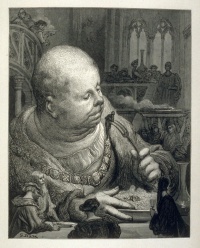Ugliness
From The Art and Popular Culture Encyclopedia
| Revision as of 17:42, 25 September 2018 Jahsonic (Talk | contribs) ← Previous diff |
Revision as of 17:42, 25 September 2018 Jahsonic (Talk | contribs) Next diff → |
||
| Line 2: | Line 2: | ||
| {| class="toccolours" style="float: left; margin-left: 1em; margin-right: 2em; font-size: 85%; background:#c6dbf7; color:black; width:30em; max-width: 40%;" cellspacing="5" | {| class="toccolours" style="float: left; margin-left: 1em; margin-right: 2em; font-size: 85%; background:#c6dbf7; color:black; width:30em; max-width: 40%;" cellspacing="5" | ||
| | style="text-align: left;" | | | style="text-align: left;" | | ||
| - | 'I never heard of "[[Ugliness|Uglification]],"' [[Alice ventured to say. 'What is it?' | + | 'I never heard of "[[Ugliness|Uglification]],"' [[Alice]] ventured to say. 'What is it?' |
| |} | |} | ||
| [[Image:Portrait_von_Antonietta_Gonzales_by_Lavinia_Fontana_ca.1594-1595.jpg|thumb|right|200px|[[Portrait]] of [[Antonietta Gonzales]] (ca.[[1594]]-[[1595]]) by [[Lavinia Fontana]]]] | [[Image:Portrait_von_Antonietta_Gonzales_by_Lavinia_Fontana_ca.1594-1595.jpg|thumb|right|200px|[[Portrait]] of [[Antonietta Gonzales]] (ca.[[1594]]-[[1595]]) by [[Lavinia Fontana]]]] | ||
Revision as of 17:42, 25 September 2018
|
'I never heard of "Uglification,"' Alice ventured to say. 'What is it?' |
.png)
|
Related e |
|
Featured: |
Ugliness is a property of a person or thing that is unpleasant to look upon. It often indicates that something provokes revulsion or horror. The term is commonly used in reference to human appearance. The opposite of ugliness is beauty.
Some argue that ugliness is a matter of subjective aesthetics, claiming that one person may perceive to be beautiful something that another may find ugly (as referenced in the popular phrase Beauty is in the eye of the beholder). However the predominant view in the scientific fields is that human ugliness is part of sexual selection and an indicator of poor genetic or physical health.
Although usually thought of in terms of a lack of physical beauty, the property of ugliness, like beauty, may also be ascribed to other phenomena, such as music, literature, human behavior, and so on.
In the 19th century the 'cult of ugliness' developed into a new aesthetic category.
Contents |
In people
People who appear ugly to others suffer well-documented discrimination, earning 10 to 15 percent less per year than similar workers, and are less likely to be hired for almost any job, but lack legal recourse to fight discrimination.
Socrates (see "The Phenomenology of Ugly", 2010) is said to have used his ugliness as a philosophical touchstone, concluding that philosophy can save us from our outward ugliness. Famous in his own time for his perceived ugliness, Abraham Lincoln was described by a contemporary: "to say that he is ugly is nothing; to add that his figure is grotesque, is to convey no adequate impression." However, his looks proved to be an asset in his personal and political relationships, as his law partner William Herndon wrote, "He was not a pretty man by any means, nor was he an ugly one; he was a homely man, careless of his looks, plain-looking and plain-acting. He had no pomp, display, or dignity, so-called. He appeared simple in his carriage and bearing. He was a sad-looking man; his melancholy dripped from him as he walked. His apparent gloom impressed his friends, and created sympathy for him—one means of his great success."
Films related to "ugliness"
- The Beauty and the Beast, 1947, Jean Cocteau
- Freaks (1932) by by Tod Browning
- The Elephant Man (1980) by David Lynch
- Shrek (2001) by Andrew Adamson, Vicky Jenson
Namesakes
- The Good, the Bad and the Ugly
- And We'll Kill All the Ugly Ones
- Ugly Woman, 1933, a traditional calypso song
- Ugly, Dirty and Bad
Ugliness in Northern Renaissance
- The Ugly Duchess (1525-30) by Quentin Matsys
Contemporary photographers fascinated with ugliness
The sublime
The sublime may inspire horror, but one receives pleasure in knowing that the perception is a fiction. Burke's concept of the sublime was a stark contrast to the classical notion of aesthetic quality in Plato's Philebus, Ion, and Symposium, and suggested ugliness as an aesthetic quality.
Cult of ugliness
Cult of ugliness refers to a relatively new phenomenon, coinciding with modern art, in the history of art theory: the rejection of classical beauty ideals and the embracing of ugliness.
Uglinesses
Bibliography
- The Aesthetics of the Ugly (1853) by German philosopher Karl Rosenkrantz
- On Ugliness (2007) - Umberto Eco
- The Ugly Woman: Transgressive Aesthetic Models in Italian Poetry from the Middle Ages to the Baroque
See also





